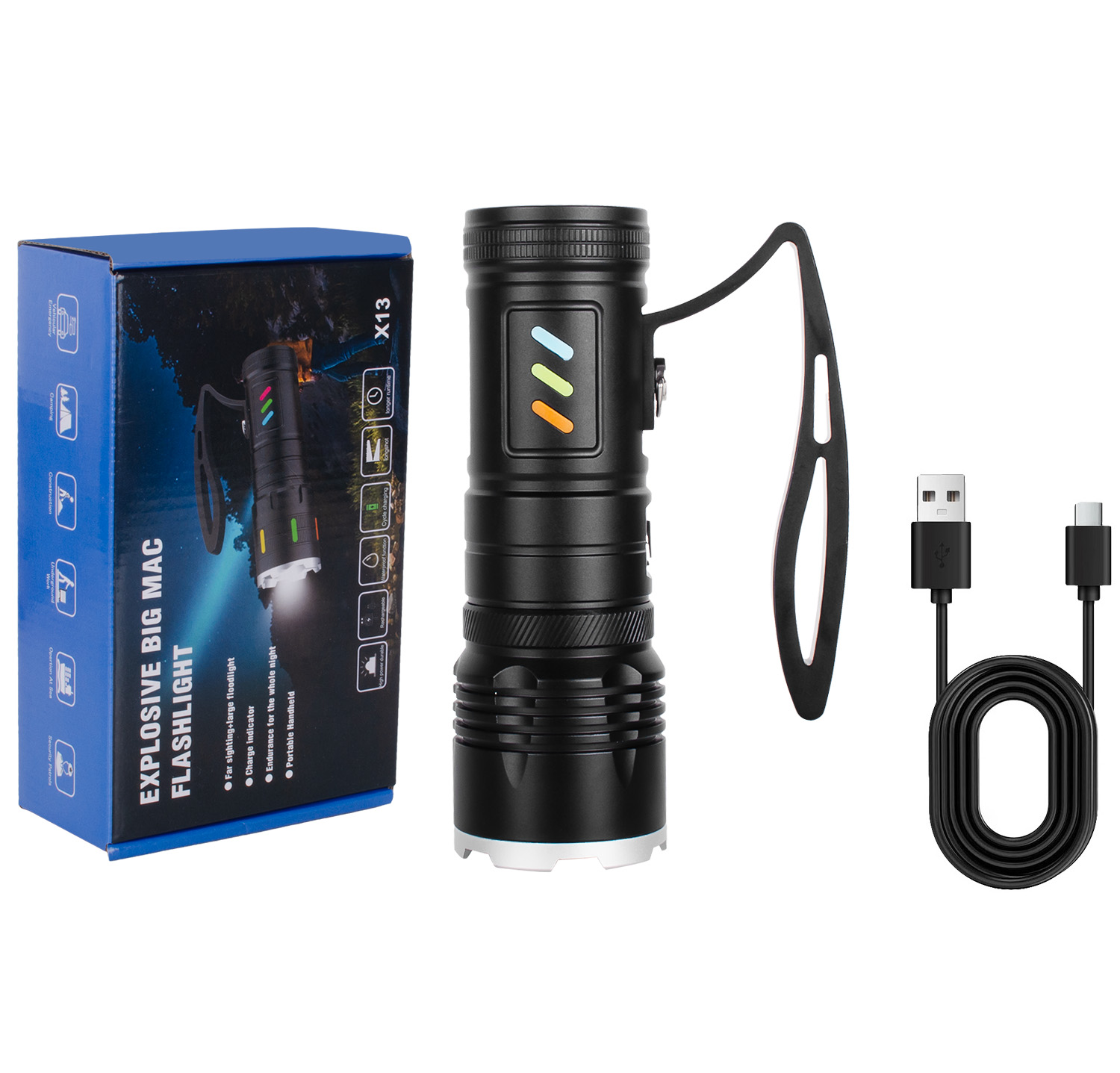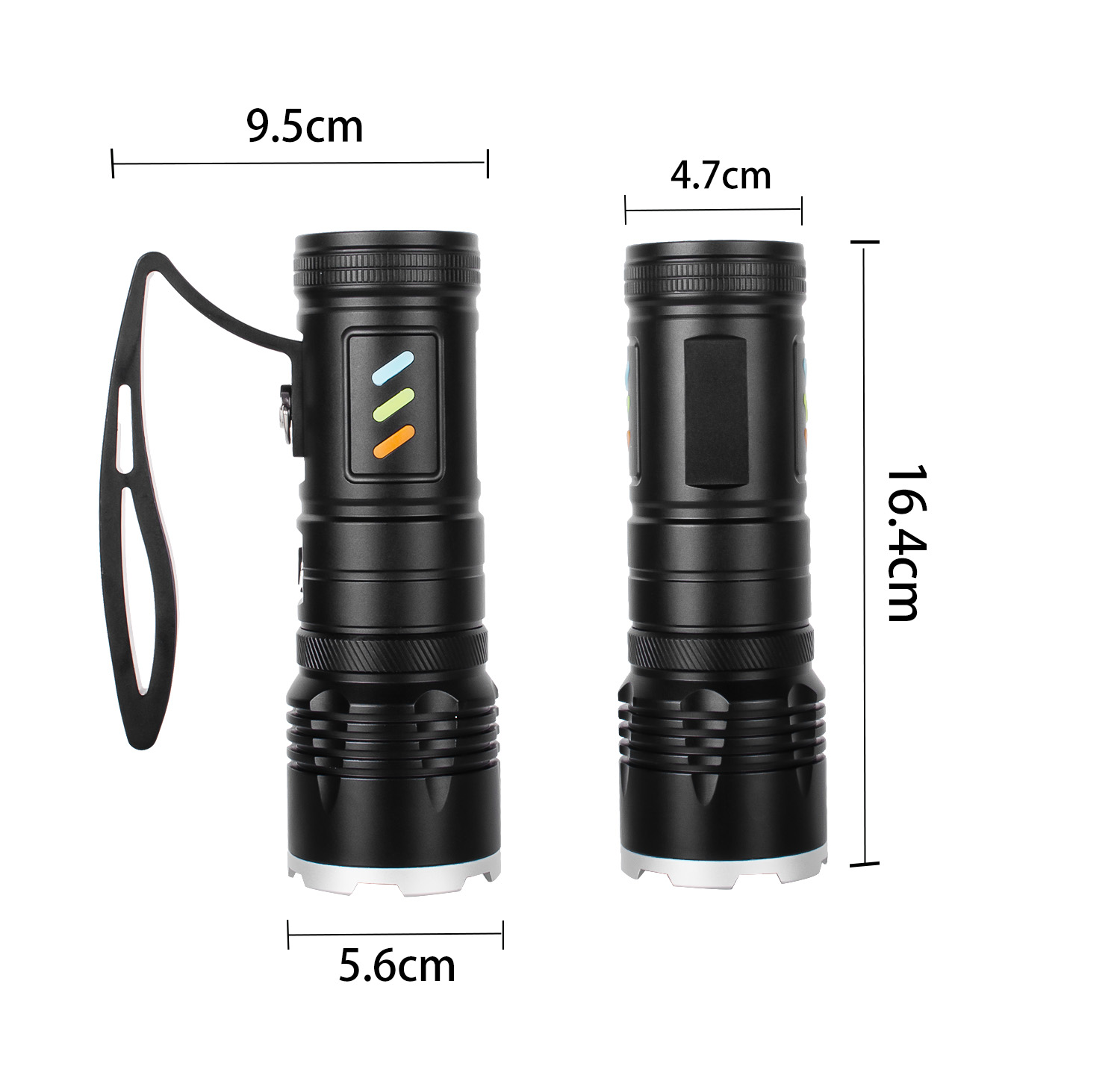Navigating the Complexities of Flashlight Imports and Exports

Understanding flashlight imports and exports plays a vital role in international trade. You must navigate the complexities of flashlight imports and exports to ensure smooth operations and financial success. For example, recent global trade data shows China exported thousands of flashlight units in various forms, including LED flashlights and tool sets. This highlights the scale of international trade in this product category. By addressing trade complexities, you can optimize pricing strategies and study market demand. These steps help you enhance profitability and remain competitive in international markets.
Navigating the complexities of flashlight imports and exports requires a proactive approach. You can achieve success by mastering international trade regulations and adapting to market needs.
Key Takeaways
Learn customs rules to avoid fines. Know flashlight trade rules for each market.
Plan shipping well to handle delays and cut costs. Use smart routes and combine shipments to save money.
Change your products to match local tastes. Study what people want to sell better in other countries.
Use tools like trade software to work faster. These tools help track stock and follow rules.
Work with skilled customs brokers to make trading easier. They can guide you through rules and prevent expensive errors.
Key Challenges in Navigating the Complexities of Flashlight Imports and Exports

Customs Regulations and Compliance
Understanding import and export regulations for flashlights
Navigating customs regulations is one of the most critical aspects of flashlight trade. You must familiarize yourself with the import and export regulations specific to flashlights in your target markets. These regulations often include safety standards, energy efficiency requirements, and restrictions on certain materials. Failing to comply with these rules can lead to significant penalties.
Non-compliance can result in:
Penalties for negligence if you fail to exercise reasonable care.
Harsher consequences for gross negligence, especially if there is a history of non-compliance.
Severe penalties for fraud, such as intentionally providing false information.
Understanding customs laws and regulations ensures you avoid compliance risks and maintain smooth operations.
Managing documentation and tariff classifications
Customs documentation plays a vital role in international shipping. You need to ensure all paperwork, including invoices, certificates of origin, and tariff classifications, is accurate. Misclassification of flashlights under incorrect tariff codes can lead to delays or higher duties. Proper documentation not only reduces compliance risks but also speeds up customs clearance.
Shipping Logistics and Supply Chain Issues
Addressing delays and cost management
International shipping often involves unexpected delays. You must plan for potential disruptions, such as port congestion or adverse weather conditions. Cost management is another challenge. Rising fuel prices and fluctuating freight rates can impact your bottom line. By optimizing shipping routes and consolidating shipments, you can reduce costs and improve efficiency.
Overcoming supply chain disruptions
Supply chain disruptions can occur due to geopolitical tensions, natural disasters, or supplier issues. To mitigate these risks, you should diversify your supplier base and maintain buffer stock. Real-time tracking tools can help you monitor shipments and address issues promptly.
Market-Specific Requirements
Adapting to regional consumer preferences
Each market has unique consumer preferences. For example, some regions may prefer compact, lightweight flashlights, while others prioritize durability and brightness. Researching these preferences allows you to tailor your products to meet local demands, increasing your chances of success in global trade.
Meeting packaging and labeling standards
Packaging and labeling standards vary across countries. In the U.S., you may need an Import Export Code (IEC) and compliance with foreign trade policies. Additional licenses or certificates might also be required. The table below highlights key market-specific requirements:
Requirement | Description |
|---|---|
Import Export Code (IEC) | Necessary for starting an import business in the U.S. |
Compliance with Foreign Trade Policy | Must adhere to the U.S. Government's regulations governing product imports. |
Additional Licenses/Certificates | Depending on the type of goods, additional documentation may be required. |
Ensuring your packaging and labeling meet these standards helps you avoid customs delays and enhances your product's appeal.
Import/Export Warehousing Challenges
Managing storage for international shipments
Managing storage for international shipments is a critical aspect of import/export warehousing. You need to ensure that your warehouse facilities can handle the unique demands of global trade. Flashlights, for example, often come in various sizes and packaging types, requiring flexible storage solutions. Proper organization helps you avoid damage to products and ensures that shipments remain intact during transit.
You should also consider the location of your warehouses. Warehouses near major ports or transportation hubs can reduce transit times and shipping costs. This proximity allows you to streamline operations and respond quickly to market demands. Additionally, implementing climate-controlled storage may be necessary for certain flashlight components, such as batteries, to maintain product quality.
Tip: Evaluate your storage needs regularly to ensure your facilities align with the growing demands of international trade.
Ensuring efficient inventory control
Efficient inventory control is essential for optimizing import/export warehousing operations. By tracking your inventory accurately, you can avoid overstocking or understocking issues. This balance ensures that you meet customer demands without incurring unnecessary storage costs.
Inventory control also plays a significant role in supply chain management. When you maintain precise records, you can plan logistics more effectively. For instance, knowing the exact quantity of flashlights available at key ports allows you to coordinate shipments seamlessly. This efficiency improves overall performance in your import/export operations.
Modern inventory management systems can further enhance your warehousing processes. These systems provide real-time data, helping you monitor stock levels and identify potential issues before they escalate. By leveraging technology, you can achieve greater accuracy and efficiency in your warehousing practices.
Note: Efficient inventory control not only reduces costs but also enhances customer satisfaction by ensuring timely deliveries.
Solutions for Global Trade Compliance and Smooth Operations
Partnering with U.S. Customs Brokerage Services
Benefits of working with experienced brokers
Partnering with experienced u.s. customs brokerage professionals can simplify your import and export operations. Brokers possess in-depth knowledge of global trade compliance and customs regulations. They help you navigate the complexities of the customs clearance process, ensuring your shipments meet all compliance requirements. Their expertise minimizes the risk of errors in documentation, tariff classifications, and other critical areas.
Working with a brokerage service also saves time. Brokers handle the customs clearance process efficiently, allowing you to focus on other aspects of your business. Additionally, they can identify cost-saving opportunities, such as duty drawbacks or exemptions, which enhance your profit margins.
Tip: Choose a brokerage service with a proven track record in flashlight imports and exports to maximize the benefits.
How brokers simplify trade compliance
Customs brokerage services streamline trade compliance by managing the intricate details of the customs clearance process. They ensure your shipments adhere to all regulations, reducing the likelihood of delays or penalties. Brokers also stay updated on changes in trade policies, helping you adapt quickly to new requirements.
By leveraging their expertise, you can avoid common pitfalls, such as misclassification of goods or incomplete documentation. This proactive approach ensures smooth operations and strengthens your position in the global market.
Leveraging Technology in Trade Management
Implementing trade management software
Trade management software offers powerful tools to optimize your import and export operations. These platforms provide features like supply chain optimization, buyer and supplier discovery, and risk mitigation. The table below highlights key benefits:
Benefit | Description |
|---|---|
Supply Chain Optimization | Enhances logistics planning and execution for importing flashlights efficiently. |
Buyer and Supplier Discovery | Access to over 2 billion records to find buyers across 200 countries easily. |
Pricing Strategies | Use price filters to target buyers that meet ideal price points for profitability. |
Risk Mitigation | Diversify supplier base using global data to reduce risks associated with sourcing. |
Competitive Supplier Engagement | Monitor suppliers' engagements with competitors to ensure they can meet your demands. |
High-Profit Product Niches | Identify products with high-profit margins using advanced filters in the trade database. |
Optimal Quality Identification | Understand the quality of flashlight products in demand based on current import price ranges. |
Using trade management software ensures you stay competitive while meeting global trade compliance standards.
Real-time tracking of shipments
Real-time tracking tools provide visibility into your supply chain. These tools allow you to monitor shipments from origin to destination, ensuring timely deliveries. By identifying potential delays early, you can take corrective actions to minimize disruptions. Real-time tracking also improves customer satisfaction by providing accurate delivery updates.
Utilizing Trade Agreements for Cost Efficiency
Identifying agreements that reduce tariffs
Trade agreements play a crucial role in reducing costs for flashlight imports and exports. Free Trade Agreements (FTAs) enable you to benefit from reduced or zero tariffs when trading with partner countries. By identifying countries with favorable agreements, you can lower your expenses and improve profitability. This strategy also helps you locate sourcing opportunities with minimal import duties.
Understanding rules of origin for flashlights
To take full advantage of trade agreements, you must understand the rules of origin for flashlights. These rules determine whether your products qualify for preferential tariff rates under specific agreements. Proper documentation and adherence to these rules ensure you maximize the benefits of FTAs while maintaining compliance with global trade regulations.
Best Practices in Import/Export Warehousing
Optimizing storage and logistics
Efficient storage and logistics are essential for managing flashlight imports and exports. You can start by investing in technology like Warehouse Management Systems (WMS). These systems automate inventory tracking and improve accuracy. With WMS, you can monitor stock levels in real time and reduce errors in order fulfillment.
Training your staff regularly is another key practice. Well-trained employees understand the latest warehousing techniques and compliance requirements. This knowledge helps them handle products more effectively and ensures smooth operations. You should also build strong relationships with freight forwarders and customs brokers. These partnerships simplify international shipping and help you navigate complex trade routes.
Unexpected disruptions can occur at any time. Having a contingency plan ensures you can respond quickly to challenges like supply chain delays or equipment failures. For example, maintaining buffer stock or identifying alternative shipping routes can minimize downtime. By implementing these strategies, you can optimize your storage and logistics processes.
Tip: Use flexible storage solutions to accommodate flashlights of different sizes and packaging types.
Ensuring compliance with warehousing regulations
Compliance with warehousing regulations is critical for avoiding penalties and ensuring smooth trade operations. You must familiarize yourself with the specific rules in your target markets. These may include safety standards, environmental guidelines, and documentation requirements.
Proper labeling and documentation are essential. Ensure that all products in your warehouse have accurate labels and meet local regulatory standards. For instance, flashlights with batteries may require special handling instructions to comply with hazardous material regulations.
Regular audits of your warehouse operations can help you identify potential compliance issues. These audits ensure that your facility meets all legal requirements and operates efficiently. Training your staff on regulatory updates also keeps your operations aligned with current laws.
Note: Non-compliance can lead to fines or shipment delays, so staying proactive is crucial.
By following these best practices, you can create a warehousing system that supports your global trade goals while maintaining compliance and efficiency.
Real-World Examples of Navigating Flashlight Trade Complexities
Case Study: Overcoming Documentation Challenges
Resolving customs delays with proper documentation
Imagine your flashlight shipment gets delayed at a port due to incomplete paperwork. This situation can disrupt your supply chain and increase costs. One company faced this issue when their shipment lacked accurate tariff classifications and certificates of origin. Customs officials flagged the shipment, causing a two-week delay.
To resolve the problem, the company worked with a customs broker. The broker reviewed the documentation and corrected the errors. They ensured the shipment met all customs regulations. This proactive approach allowed the company to clear the shipment and avoid additional penalties.
You can learn from this example by double-checking your paperwork before shipping. Accurate documentation ensures smooth customs clearance and prevents costly delays.
Lessons learned for future shipments
This case highlights the importance of preparation. You should create a checklist for all required documents, including invoices and certificates. Partnering with experienced brokers can also help you navigate customs regulations effectively. By adopting these practices, you can minimize risks and streamline your operations.
Case Study: Adapting to Global Trade Compliance Standards
Meeting EU safety and quality requirements
A flashlight manufacturer wanted to expand into the European Union. However, the EU has strict safety and quality regulations. The company needed to meet standards for energy efficiency and hazardous materials. Non-compliance would have resulted in rejected shipments and financial losses.
The company invested in testing and certification for their products. They worked with experts to ensure compliance with EU regulations. This effort allowed them to enter the market successfully and build trust with European consumers.
The impact of compliance on market success
Meeting compliance standards gave the company a competitive edge. Their products gained a reputation for quality and reliability. This success increased their market share and boosted profits. You can achieve similar results by prioritizing compliance in your trade operations.
Tip: Research the specific regulations of your target market to ensure your products meet all requirements.
Future Trends in Flashlight Imports and Exports

Sustainability in Flashlight Manufacturing and Trade
The rise of eco-friendly materials and packaging
Sustainability is becoming a key focus in flashlight manufacturing and trade. Many companies now use eco-friendly materials like recycled aluminum or biodegradable plastics. These materials reduce environmental impact and appeal to eco-conscious consumers. Packaging is also evolving. Businesses are replacing traditional plastic wraps with recyclable or compostable alternatives. This shift not only meets consumer demand but also aligns with global sustainability goals.
How sustainability influences global trade compliance
Sustainability directly impacts trade compliance. Many countries enforce strict environmental regulations for imported goods. For example, the European Union requires compliance with its eco-design standards. You must ensure your flashlights meet these requirements to avoid customs delays or penalties. Adopting sustainable practices can also open doors to markets with green trade incentives, giving you a competitive edge.
Automation in Trade Processes
The role of AI in customs clearance
Artificial intelligence is revolutionizing customs clearance. AI tools analyze large volumes of data to identify potential compliance issues. These tools can flag errors in documentation or tariff classifications before submission. By using AI, you can reduce processing times and avoid costly mistakes. This technology also helps you stay updated on changing customs regulations, ensuring smooth operations.
Predictive analytics for supply chain management
Predictive analytics is transforming supply chain management in the flashlight trade. It enhances demand forecasting, helping you anticipate market needs accurately. It optimizes inventory levels, reducing waste and ensuring timely deliveries. Predictive tools also improve risk management by identifying potential disruptions in advance. These benefits streamline your operations and boost customer satisfaction.
Predictive analytics enhances demand forecasting, allowing businesses to anticipate market demands effectively.
It optimizes inventory levels, reducing waste and ensuring timely deliveries to customers.
It improves risk management by providing foresight to prevent disruptions in the supply chain.
Growth of E-Commerce in Flashlight Trade
Challenges of cross-border e-commerce
Cross-border e-commerce presents unique challenges for flashlight trade. Customs regulations vary by country, making compliance complex. Shipping costs and delivery times can also deter customers. Additionally, managing returns across borders adds logistical hurdles. You must address these issues to succeed in the global e-commerce market.
Opportunities for small businesses in global markets
E-commerce offers immense opportunities for small businesses. Platforms like Amazon and Alibaba allow you to reach international customers without significant upfront investment. By leveraging these platforms, you can expand your market reach and increase sales. Offering localized products and competitive pricing further enhances your chances of success.
Navigating the complexities of flashlight imports and exports is essential for global trade success. You must address challenges like compliance, logistics, and market-specific requirements to stay competitive. Leveraging technology, such as trade management software, simplifies operations and enhances efficiency. Building partnerships with customs brokers ensures smooth processes and reduces risks.
Tip: Seek expert guidance to avoid costly mistakes and maximize opportunities in international markets.
By combining these strategies, you can overcome trade barriers and position your business for long-term growth. Take proactive steps today to thrive in the global flashlight trade.
FAQ
What are the most common challenges in flashlight imports and exports?
You may face issues like customs compliance, shipping delays, and supply chain disruptions. Market-specific requirements, such as labeling standards, can also complicate trade. Addressing these challenges requires careful planning, accurate documentation, and a strong understanding of global trade regulations.
How can you ensure compliance with customs regulations?
You should research the import/export rules for your target markets. Use accurate tariff classifications and complete all required documentation. Partnering with a customs broker simplifies the process and reduces the risk of errors. Staying updated on regulatory changes also helps you maintain compliance.
What tools can help you manage flashlight trade operations?
Trade management software offers features like inventory tracking, supply chain optimization, and real-time shipment monitoring. These tools improve efficiency and reduce risks. You can also use predictive analytics to forecast demand and identify potential disruptions in your supply chain.
Why is sustainability important in flashlight trade?
Sustainability appeals to eco-conscious consumers and aligns with global environmental goals. Using eco-friendly materials and packaging reduces your environmental impact. Many countries also enforce strict environmental regulations, so adopting sustainable practices ensures compliance and opens doors to new markets.
How can small businesses succeed in global flashlight trade?
E-commerce platforms like Amazon and Alibaba allow you to reach international customers. Focus on offering localized products and competitive pricing. Partner with reliable logistics providers to ensure smooth shipping. Leveraging trade agreements can also reduce costs and improve profitability.
Tip: Start small by targeting one or two key markets before expanding globally.
See Also
Finding Premium Flashlights for Your Wholesale Import Business
Understanding Various Applications for Flashlight Use
Boosting Profits by Purchasing Flashlights at Wholesale
A Comprehensive Overview of Flashlight Production in China
The Intriguing Journey of Flashlight Manufacturing Explained
